Greener and




Cleaner ON THE MONEY Solar energy comes to small towns Inuk artist designs new silver coin
New Music from The Flummies Top Secret Nuclear Mission
Larry Jenkins photo




To subscribe, renew or change address use the contact information above.

Canada Post Canadian Publications Mail Sales Product Agreement #40062919
The advertiser agrees that the publisher shall not be liable for damages arising out of errors in advertisements beyond the amount paid for the space actually occupied by the portion of the advertisement in which the error occurred, whether such error is due to the negligence of the servants or otherwise, and there shall be no liability beyond the amount of such advertisement. Pen names and anonymous letters will not be published. The publisher reserves the right to edit, revise, classify, or reject any advertisement or letter.




© 2022 Downhome Inc. No part of this publication may be reproduced in any form without permission of the publisher.
Printed in Canada
2 inside LABRADOR FALL 2022
1-888-588-6353 • www.insidelabrador.ca
Editor Nicola
Art Director
Distribution
Subscription Representative
Advertising Sales Account Manager Barbara Young Account Manager Ashley O’Keefe
Director
CEO Grant
President
Associate Publisher
General Manager and Assistant Publisher Tina
Editor-in-chief Janice Stuckless Assistant
Ryan
Vince Marsh
and
Marlena Grant
Marketing
Tiffany Brett Publisher and
Young
and
Todd Goodyear
Bromley







46 table of contents 52 50 Views of Red Bay 52 Powered by the People Home grown green energy 60 He’ll Be Home for Christmas Reuniting a family 62 Labrador Schooner Legacy Rebuilding the past 64 Photo Finish 6 Editor’s Note 8 From Our Readers 10 45 Years & Counting Catching up with The Flummies 16 Mid-Century Memories Life in 1930-40s Labrador 24 A Survivor’s Account Reliving the MV William Carson sinking 30 Labrador Life 32 A Combined Effort Labradorians working together for good 36 Labrador and the Nuclear Age A secret mission to the Big Land 40 A Warm Welcome Outdoor fun for newcomers to Labrador 46 Generations of Storytelling An Inuk artist’s work is honoured FALL 2022 4 inside LABRADOR


There is a line

from Linda Browne’s article, “Powered by the People” (page 52-59), that really struck a chord with me. It’s something that Nick Mercer, a postdoctoral research scholar at Dalhousie University and independent energy adviser to the NunatuKavut Community Council, said about finding sustainable living solutions in the region. “I think there’s a really sophisticated and rich Indigenous knowledge system in there that can teach us untold amounts about how we treat one another, about how we manage our lands and resources, about how we make fair decisions that benefit everyone in the community.” That same theme of working together and listening to Labradorians is echoed in “A Combined Effort,” an essay by Stanley Oliver about the importance of cooperation for the common good of Labrador and Labradorians.





It’s their innate knowledge of the land and how it supports life, their instinct to take care of each other, and their determination to push for better and not settle for less that impress me about Labradorians. We encounter a broad range of people and stories when putting together each issue of Inside Labrador. But there is a thread that binds them all, one that’s spun from a pride of place, a deep love and respect for the land and waters, and a strong sense of community. It’s a big land of big hearts, big dreams and big moves.
for reading, Janice Stuckless Editor-in-chief janice@downhomelife.com
6 inside LABRADOR FALL 2022
Thanks
Everyone has a tale to tell.
And we want to see your stories about Labrador. Maybe it’s a recollection of the way things used to be, or a historical piece, or a story about somebody doing great things in your community. Maybe it’s a travel story about a trip somewhere in the Big Land. Whatever your story, in verse or in prose, our readers would love to see it and so would we.
If you’re better with a camera than a keyboard, you’re in luck, too - we’re also looking for photos of Labrador. From snapshots while berry picking to compositional studies of the landscape and everything in between, we love looking at your images.

Published submissions will receive $20 in Downhome certificates to spend in our stores and online at
Send your photos and stories to editorial@downhomelife.com or upload them to our website at Downhomelife.com/submit.
www.shopdownhome.com.
From Our Readers



Goose Bay Memories


My father was stationed at Goose Bay from 1948 to 1950. In those days, Goose really was a “fly-in community,” as we depended on 426 Squadron’s North Stars for contact with the outside world. Bulk supplies like flour came in by sea, aboard Captain Gullage’s Blue Peter. One winter, we shared our big bag of flour with a large family of hungry mice. Fortunately, Augusta taught us how to make bannock, so we were able to keep pace with the mice in the culinary department, ensuring that all (mice and people) stayed fed until the arrival of more flour in the spring. Great times!




8 inside LABRADOR FALL 2022
Some photos of Station Goose Bay circa 1949
Courtesy Vic Gray via www.c-and-e-museum.org
PETER ROBERTSON Ottawa, ON
 BY WENDY ROSE
BY WENDY ROSE





10 inside LABRADOR FALL 2022
The Flummies have a new album out and plans to keep “spreading the love”of Labrador music.
From casual kitchen parties to main stages around the world, Labrador band The Flummies have certainly made their mark on the Newfoundland and Labrador music scene. Founded in 1978, they’re still putting out new music and hitting the road with their brand of Indigenous country/rock. In 2021, their hard work was officially commemorated with MusicNL’s Honorary Lifetime Achievement Award.


inside LABRADOR 11 FALL 2022
“When the nomination for Lifetime Achievement came up, we were very happy to accept,” says guitarist and vocalist Leander Baikie. “Makes you feel old,” he adds with a laugh, “but also lets you know that people continue to recognize us as longtime musicians in our wonderful province.”






He notes, “Over the past 20 years, we have won a few awards from the NL music association and the East Coast Music Association. It would be great to be nominated once again for a music award.” With their latest album
Brothers on the River being released in 2021, we might see The Flummies nominated for a 2022 MusicNL Award later this year.

To understand exactly why The Flummies were so deserving of their Lifetime Achievement Award, we have to go all the way back to Goose Bay in 1977, where Alton Best, Maurice Best, Winston White and George Shiwak were getting ready to perform at a folk festival. A young Richard Dyson was backstage, set to perform solo on the accordion, when he was invited to

12 inside LABRADOR FALL 2022
Early days of The Flummies, including one of the founding members, Alton Best (right)
join the band on stage.
“Richard said he wasn’t sure about it at first, but was eager to follow the list of Labrador songs that the boys had lined up for their set,” Leander explains. “There have been many unrecorded songs written about the lives and the hunting times of the people that lived in the early central Labrador communities of Mud Lake, Happy Valley and North West River. Songs were passed down through the generations verbally, but were never recorded on a record for
explains. The Flummies current lineup is Leander Baikie (vocals/rhythm guitar), Simeon Asivak (bass), Tunker Campbell (vocals/lead guitar) and Richard Dyson (accordion) – the only remaining founding member.
Labrador Music History

“Anyone who has lived and worked in central Labrador for a number of years would understand the musical culture upon which Labrador music is built,” Leander shares. “The American mili-
radio. This is what made The Flummies special, as they were actually singing songs about our land from a stage that had only previously been heard at kitchen parties.”
After the show, the group invited Richard to officially join the band and The Flummies were born. A flummy is “a Labrador trapper’s bread, made from flour, water and baking powder, that is as unique to the Labrador people as are the songs,” Leander
tary [at Goose Bay Air Base] was a huge part of the Labrador culture for about 50 years… The base itself back in the 1970s had a dozen militarysupported mess halls and nightclubs… so us local people started learning music… The clubs would bring in state-side bands – these guys all left a country music influence on us all. Of course, we do like to play rock and roll, but the Irish songs from the capital city of St. John’s brought us its many jigs

inside LABRADOR 13 FALL 2022
This is what made The Flummies special, as they were actually singing songs about our land from a stage that had only previously been heard at kitchen parties.
The Flummies perform in West Germany, 1988












and reels. It came through to us from provincial radio and through the early days of local television.”
Leander continues, “Richard said the traditional music actually came from our mothers and fathers. The songs came from life experiences of our elders, who would essentially ‘whistle while they worked.’ The new songs written by The Flummies continue to be inspired by the Labrador scenery, the Indigenous culture and our continued life on the land.”
The Show on the Road

In 1988, The Flummies released their second album, Songs of Labrador. This proved to be a game-changing career move that would eventually send them “across the pond” to Europe, invited by German crews for a trip to their homeland for one show. One appearance turned into a string of four sold-out shows.
“What an awesome trip,” Leander
says. “We were just local boys from Labrador being treated like kings in another country. It was a wonderful experience for us.”
The band had another memorable experience on tour in 1999, when they performed on the grounds of the CN Tower in Toronto, ON. They were representing Newfoundland and Labrador as part of a Canadian tourism initiative.
“Lots of people from all across Canada were there, and some expatriates from Newfoundland and Labrador. It was good comradery amongst our provincial group,” he says. “We had stone carvers, seamstresses, knitters, Innu tea doll makers. We all kinda hung out together in the evenings. This event really brought the band together. A great audience from all over the world attended every show… Never did know if they understood what we were talking about from the stage as we described each song,”
14 inside LABRADOR FALL 2022
Leander laughs.



In more recent years, a lot of The Flummies touring has been centred around northern Canada, where the energy at shows is “different from anywhere else,” Leander says, although audiences are always especially excited about the accordion.
“The fun part for us on these trips to the smaller communities is the challenge of using whatever band equipment is left on stage… The other great part about up North is being able to sell a box of CDs from the stage. There are not many places left in the world where you can do this anymore,” he adds.
Of course, the COVID-19 pandemic changed the band’s ability to tour in 2020-21, but they made the most of it by returning to the studio for the first time in 10 years, thanks to a grant from Canada Council for the Arts. “We certainly took advantage of the time away from the stage for longterm musical gain, if nothing else,” Leander muses.

“In 2021, we were still stuck inside… I think we played maybe three times in three years,” the guitarist recalls. “Now that the new album is released and new summer venues are opening up, it will be the busiest we have been in three years, thankfully. A new album will always bring a new round of requests for performance… People will once again ask, ‘When are you playing? Where are you playing?’
“With Brothers on the River, The Flummies are on the mark, once again, to make something new and exciting happen with our band and our music. We still have nine albums worth of original songs to be sung from the stage. Many of our radio hits are still being played on commercial and community radio!” Leander hopes that radio stations across Canada, especially in the North, will continue playing The Flummies’ older hits as well as some new selections from their 2021 album.
“We love to travel as a band and spread the happiness of the accordion music from Newfoundland and Labrador,” Leander shares. “All we really want to do is play music for people in different towns for different audiences in our province, and spread the love, if you will.”
inside LABRADOR 15 FALL 2022
BY BURTON K. JANES




16 inside LABRADOR FALL 2022
The late William Gillett’s photographs offer insight into 1930s and 1940s Labrador
The only house in Postville, 1940. Bill Manak and his wife stand in the doorway, flanked by William and Matilda Gillett.
William Gillett was born in Humbermouth in western Newfoundland in1906. He spent 40 years in Labrador as a pastor with The Pentecostal Assemblies of Newfoundland and Labrador. Exhibiting both personal foresight and initiative, he focused on people’s spiritual, economic and educational needs. Since his death in 1977, scholars have praised his many contributions to the fabric of the Labrador communities in which he served.
Now, through the acquisition of a treasure trove of vintage images, I am able to document aspects of Gillett’s life and career in a photo retrospective. Most of the 50 or more pictures, of varying quality, remain unidentified and have not been published before. William Gillett’s son, Everett (1931-2017), made them available to me in 2000. I am grateful to Everett’s son, Eugene, for granting permission to reproduce them. I have selected several of the most interesting, wide-ranging pictorial depictions to demonstrate William Gillett as a builder of community, churches, schools and sawmills. I have provided captions, some of them educated guesses.

inside LABRADOR 17 FALL 2022
Children dressed in their Sunday-goto-meeting clothes






18 inside LABRADOR FALL 2022
The portable sawmill Gillett set up at Postville
The Gospel Messenger, constructed in 1930-31, expressly to spread the Pentecostal message on the Labrador






inside LABRADOR 19 FALL 2022
Matilda Gillett holding a child
A winter excursion in the woods
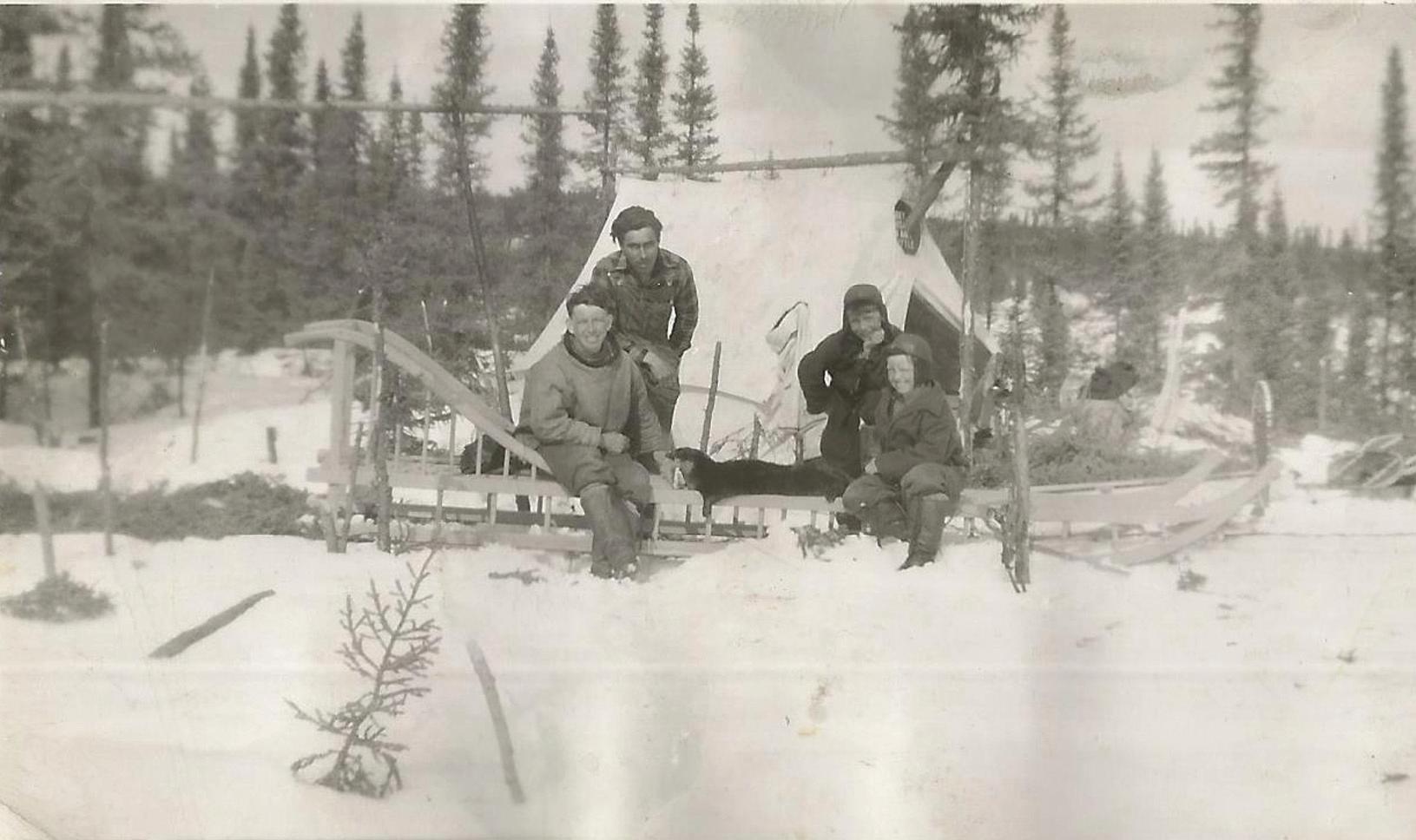





A placid harbour scene

20 inside LABRADOR FALL 2022
Continued on page 22
Huskies anxious to get started on another trip








inside LABRADOR 21 FALL 2022
The second parsonage built in Postville in 1941-42. The first pastors’ residence had been torn down.





First Pentecostal school in Labrador – Postville, late 1940s. Prior to Gillett building the schoolhouse, the children along the coast would be picked up by the SS Kyle and delivered to the Grenfell Mission at North West River, where they would stay from the fall to the next summer.

22 inside LABRADOR FALL 2022








inside LABRADOR 23 FALL 2022
A Christmas party in the school classroom
A tractor hard at work in the woods
Children standing among the kill




24 inside LABRADOR FALL 2022
SUBMITTED BY BRIAN KERR
The following is my elderly grandfather Bertram Simmons’ story of the sinking of the MV “William Carson” on the night of June 2 through the early morning of June 3, 1977. With the exception of a few minor spelling/grammar edits, these are his exact words.
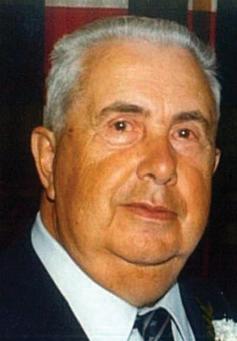
Sitting together in #4 lifeboat with a huge tarpaulin over our heads, I heard one male passenger say, “I don’t care if she sinks now, or stays afloat all night, I’m happy! I got a bottle of whiskey, and we can all have a few drinks.” The bottle was passed around with the caution to “…only take one mouthful.” Then, seeing the figure of a man standing outside our tarpaulin, the man who had produced the bottle said, “…and give that poor old bugger a drink, too! He may be cold.”
Unfortunately, this was the worst thing that could have happened, for that particular figure standing sentinel outside was the crew member in charge of our lifeboat. He announced in a rather loud voice that he was confiscating the bottle as it was against regulations. Morale for our little party seemed to wane a little at that point.
Huddled under the tarpaulin there were approximately 20 of us passengers that sat and waited. No one had been introduced to each other; we all sat there not knowing another soul. Later, I learned that some had come from as far away as California. Some smoked cigarettes, some told smutty jokes, some laughed and some remained stoically quiet. Everyone seemed tense, cold and uncomfortable. Our lifeboat was now well beached on a large pan of ice. How on earth would we be rescued? I wondered to myself.
Less than 100 yards away loomed large the CN ferry, MV William Carson, mortally wounded by heavy ice. The 8,000-plus ton vessel, the pride of the CN fleet, was slowly sinking, yet her lights were all still ablaze – she reminded me of a giant Christmas tree! The heavy ice had made a hole in her bow and she sat there resting in the ice, certainly doomed.

FALL 2022 inside LABRADOR 25
How I ended up here
At 10:30 p.m. on May 31, 1977, I had left my home in St. John’s for a round trip down on the Labrador to Goose Bay and return – a little adventure estimated to take eight days. The first port of call would be Lewisporte in Notre Dame Bay, and this was reached at around 1:00 p.m. the next day. In Lewisporte, a great deal of freight was loaded aboard, including something like 50 small Volkswagen cars bound for a dealership in Labrador. We set sail from Lewisporte at midnight with one more scheduled stop in St. Anthony before leaving the security of the Island behind. We reached St. Anthony at 10:00 a.m. the next morning (June 2).
The proposed next leg would have us crossing the Straits, calling in at Cartwright and finally Goose Bay. We left St. Anthony at about 2:00 p.m. and passed through open water for about three hours when the first ice was seen. Initially, it seemed easy to get through, but later on became quite
close-packed and very difficult to penetrate. The ship was making slow progress.
I was closely watching the tightly packed ice from the top deck, watching some birds and hoping to see if any seals were around. I went down to my cabin three decks below to get a pair of binoculars. As I unlocked my cabin door, I heard a bell ringing and noticed a large steel door starting to close. I immediately made for the elevator but was stopped from entering by a crew member who told me that the ship was in trouble and not to take the elevator, but to go at once to my assigned boat station up on deck.
As I started to walk up the first set of stairs, I met another crew member coming down with a large pipe wrench. I asked him, “What kind of trouble is the ship in?” He mumbled something about the ship taking on water…


Upon my arrival at the boat deck, the crew were all efficiently moving around, and all the passengers were

26 inside LABRADOR FALL 2022
MV William Carson
there, some with small children in arms. Everyone was talking and asking questions. One passenger exclaimed, “What are we up here for?”
“I really don’t know,” responded another.
Another passenger spoke up and said, “A boat drill, I think.”


“We may have to leave the ship?” I heard someone else ask, while another said, “She may have struck an iceberg, and we’re all gonna be put out on the ice!”
A reassuring voice added, “The Coast Guard ship Sir Humphrey Gilbert will save us – apparently she is only 65 miles away.”
Several passengers asked if they could go back to their cabins and try to save some belongings, but this was not permitted. They were told outright that it was too dangerous now, and the ship was unstable – it could sink in a hurry!
About that time there was an order from the bridge: “All passengers assemble inside.”
We were no sooner inside, when the crew began opening large cupboards and taking out blankets and life jackets. Everyone was handed a blanket
and instructed to put on lifejackets. Then we all assembled once more outside on the deck and were told to get in the lifeboats, which had by now been lowered to deck level.
All passengers climbed aboard in a surprisingly orderly fashion. Three lifeboats seemed to be launched from the starboard side, and three were launched from the port side. There was no water to be seen, and the lifeboats came to rest on the large pans of ice. By pushing and shoving with the oars as well as some boat hooks, we gradually managed to move somewhat clear of the ship – a distance of about 100 yards.
The time was then about 10:00 p.m. The sky was bright and clear, with only a light wind blowing, as we watched the huge ship slowly becoming more and more submerged at the head.
inside LABRADOR 27 FALL 2022
The Carson still appeared majestic, totally proud and completely illuminated, and she remained all lit up right until the very end.
The Carson still appeared majestic, totally proud and completely illuminated, and she remained all lit up right until the very end. She was an electric diesel vessel, and as she sank power remained until the salt water reached her generators, which seemed to be situated near the top deck. She had been damaged some time just before 9:00 p.m., but did not sink until about 2:00 a.m. the next morning, June 3.
I had never seen a ship “die,” and those long moments watching the grand ship in agony saddened me quite a bit. She stood on end, her stern rising up in the air like a large building – all lights ablaze – her bow tipped forward. She looked like she was standing on her head as she went down halfway. At that instant, all her lights extinguished and the entire ship went black. There were some loud crashes and irregular, thunderous bangs emitted from inside the hull. Some 20 or 30 seconds later, she slid beneath the ice, tipping her stern over like an enormous whale slowly diving, with about 20 feet of her keel along with her twin propellers clearly visible
as she submerged. Less than five minutes later, she was gone from our sight. The ice came together, leaving no sign that a ship, or anything else for that matter, had ever existed there. It was as if she had been swallowed up by the ice! The next few moments of intense silence were the strangest and strongest I had ever experienced.
In the lifeboat, nobody spoke as we hauled our tarpaulin up again and sombrely hid our heads, feeling some shame. Our only option now was to settle in and await rescue with quiet reflection, and perhaps some prayers.
Around 3:00 a.m., we began to hear

















28 inside LABRADOR FALL 2022
A small helicopter plucked a handful of people off the ice before a larger one rescued the remaining survivors.
and see planes overhead. Flares were randomly sent skyward from our boat and others during that timeframe.

At approximately 4:30 a.m., a small helicopter landed on the ice. It took off again with some passengers from a few of the other lifeboats, which were about a mile away from us at that point. That small helicopter could only take four to five people at a time and was apparently flying those folks away to Mary’s Harbour in Labrador.
Within an hour afterwards (maybe 6:00 a.m.), a huge Labrador helicopter roared overhead and came down directly on the ice near our boat. She took us all (at least 20 people), and once aboard, we were immediately flown to St. Anthony Hospital. Upon our arrival we were looked over by medical staff, given our breakfast and permitted to phone our relatives, who were desperately waiting for any news. Following that fever of communications, the same big Labrador helicopter flew us all the way to Torbay Airport in St. John’s. Next, we were transported downtown by bus to the Hotel Newfoundland, where we were treated like royalty.




Well, I had my hopes set on an eight-day vacation, but was back in St. John’s in less than three days. How-

ever, I got on television and radio, was interviewed on the telephone by reporters from the Canadian Press along with many other journalists, and I even got a ride in a large fancy helicopter! I wonder what my 77th year will have in store for me?

inside LABRADOR 29 FALL 2022
Bertram in his later years wears the lifejacket given to him on board the Carson that fateful night.
Labrador Life
Where Seasons Meet
Fresh snow dusts the Rigolet boardwalk, where the trees are still dressed for fall.





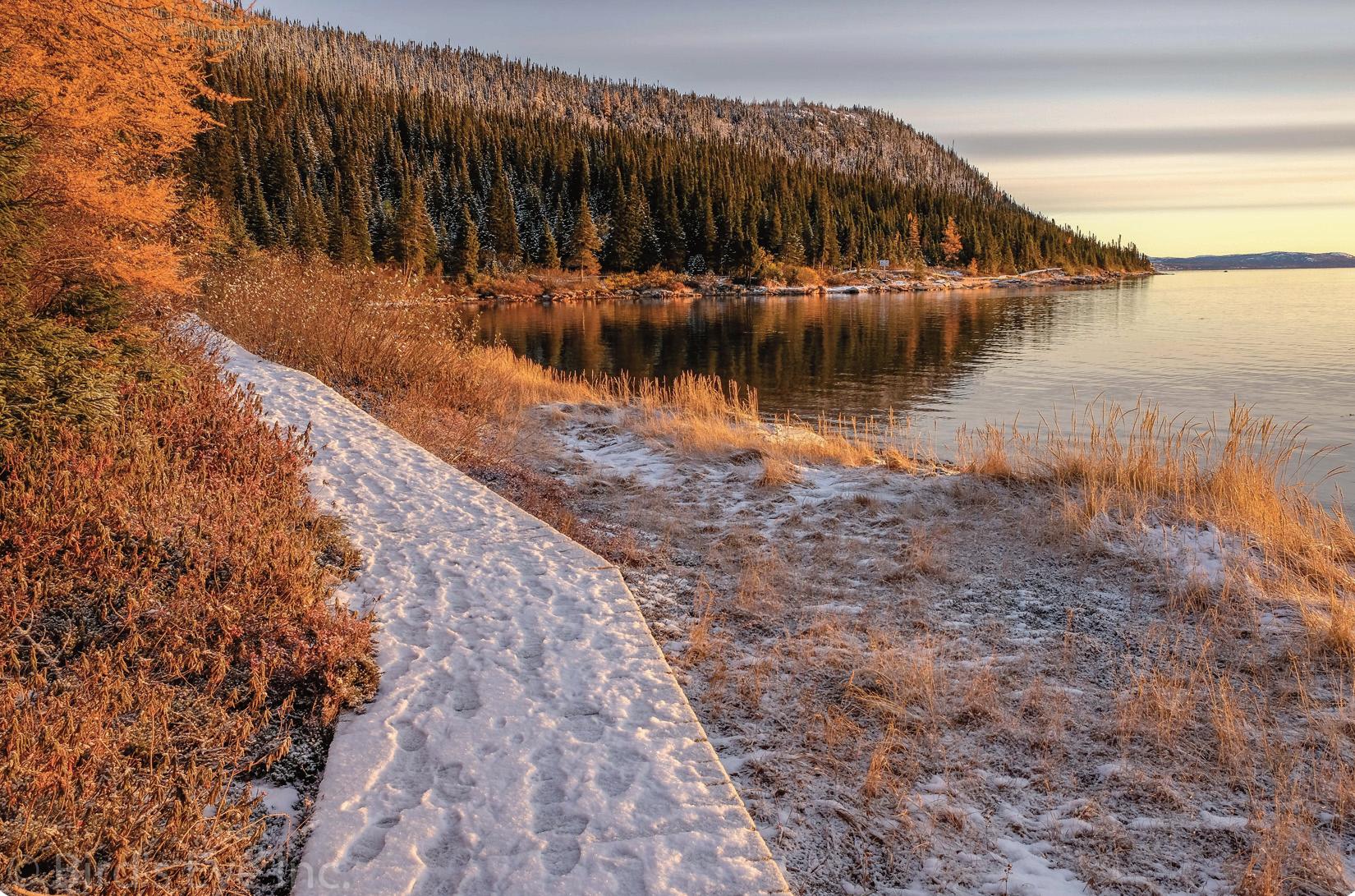

 ELDRED ALLEN
ELDRED ALLEN
Rigolet, NL
Checking Out the Falls
Caleb Oldford Broomfield, 8, and his sister, Irellyn Oldford Broomfield, 7, were glad to see the mighty Churchill Falls.
CARLA
OLDFORD Happy Valley-Goose Bay, NL
30 inside LABRADOR
FALL 2022
Out for a Stroll

Lincoln and Raina Rolfe exploring on a beautiful fall day in St. Lewis, a few years ago.

VANESSA POOLE St. Lewis, NL

inside LABRADOR 31 FALL 2022
BY STANLEY OLIVER
The idea of combined councils, as it applies to the administration of government relations, was not new to the province when the citizens of Labrador first created one in the 1970s.



As early as 1832, under what was then Newfoundland’s Representative Government, the British governor appointed a Board of Council (also known as Legislative Council), which had the power to pass laws governing the colony. Also appointed was an Executive Council to advise the governor, who in turn reported to the British Colonial Office, which ultimately influenced the

32 inside LABRADOR FALL 2022
How Labradorians have harnessed the power of working together for common good
manner in which Britain governed Newfoundland.
Moving forward, on November 3, 1908, Newfoundland saw the formation of its first community grassroots union and official political party. The Fishermen’s Protective Union (FPU) developed into a social, economic and political force. Founded by the charismatic William Coaker, the FPU worked to provide fishers and their families with a greater share of the wealth for their labour. From about 1913-1917, the FPU influenced government policy.
The very first advancements by Newfoundland communities towards regionalization happened in 1951, with the establishment of the Newfoundland and Labrador Federation of Municipalities – now Municipalities Newfoundland and Labrador (MNL). MNL’s mandate was and still is to “advocate and promote the views of municipalities on matters of common interest, and to attempt to advance and present a united approach to the two levels of government” (federal and provincial).

In 1952, the first joint council in the province was formed to create a united
stance on issues important to the region. The Burin Peninsula Joint Council (BPJC) acted as an informal body of primarily elected mayors and councillors from member communities with no real authority. More joint councils would be formed around the island and continue to operate today.
Back to Labrador. Following the Royal Proclamation of 1763, the governor of Newfoundland controlled the coast of Labrador, and the Hudson’s Bay Company (HBC) controlled the interior. The boundary, however, was never clearly defined, and Quebec and Newfoundland governments argued over its definition for more than 160 years. Finally, in 1927, a judicial committee decided on a border and Labrador as it is known today came under the jurisdiction of Newfoundland. It took until 2001, though, for the province to be officially renamed Newfoundland and Labrador.
The last Father of Confederation, Joey Smallwood, ran the province from 1949 until 1972 with an iron fist. Unfortunately for them, Labradorians
inside LABRADOR 33 FALL 2022
were not elected to the House of Assembly, but rather their representatives were appointed by Smallwood.
Prior to 1972, major natural resource developments were underway in the Labrador territory (iron ore mining, Churchill Falls hydroelectricity, linerboard manufacturing) without the real acknowledgement and participation of Labradorians. There appeared to be, and there was, a total disregard for the Indigenous people of the time.
During the end of Smallwood’s reign, the people of Labrador began to

communities of Nain, Hopedale, Makkovik and Davis Inlet. Regrettably, the organizers (Memorial University, Ian Strachan) forgot to invite the community of Rigolet. However, Bill Shiwak of Rigolet did attend.
The newly formed Combined Councils of Northern Labrador made the meeting’s resolutions available publicly via the Labrador Inuit Association’s newsletter, Kinatuinumot Illenyajuk. Of particular interest was Resolution No. 1: “whereas the land owned by the natives, Eskimo and
Joey Smallwood ran the province from 1949 until 1972 with an iron fist. Unfortunately for them, Labradorians were not elected to the House of Assembly, but rather their representatives were appointed by Smallwood.
find their voices. They became more informed about government policies, became educated and ultimately became very concerned about how their communities were being impacted by major developments. More importantly, they began to organize, establishing the New Labrador Party, the Naskapi Montagnais Innu Association, the Labrador Inuit Association, the Labrador Métis Association, the Labrador Friendship Centre and the Combined Councils of Labrador. This public interest by Labradorians would significantly change the face of politics in Labrador.
It was after one of the toughest winters ever recorded, and the well-known Nain stove oil issue, that coastal communities established the Combined Councils of Northern Labrador in 1972. The first meeting was held in the community hall of Hopedale in mid-April. It included the northern
Indian [terms used and considered acceptable of the day], since no agreement has ever been signed to pass over to any authority.”
The Combined Councils of Northern Labrador worked tirelessly to bring their issues to the forefront and continued to meet throughout the 1970s. One of the greatest accomplishments of their lobby efforts was Labrador getting its own federal electoral riding. It took a long time before the federal government would act, but in 1988, Liberal Bill Rompkey was elected as the first Member of Parliament for the riding of Labrador. He held this position in successive elections until 1995, after which he was appointed to the Senate.
It was at the Combined Councils of Northern Labrador’s eighth meeting, in North West River in 1979, that the new Combined Councils of Labrador (CCL) was born. It represented all
34 inside LABRADOR FALL 2022
regions of the Big Land, with delegates from 21 communities. Delegates decided to divide Labrador into five regions and they elected Lloyd Dalton (of Happy Valley-Goose Bay) to serve as the first president.
It’s important to give credit to the late Doris Saunders (founder and former editor of Them Days magazine), who remarked, “If there is one thing that has struck me about the ’70s, it has been the coming to life of the people of Labrador. By coming to life, I mean that the Labrador people are becoming outspoken – more ready to assume leadership roles. For such a long time it appeared that people from outside of Labrador were the only ones heard and the ones making all the decisions. That’s over!”
On his resignation as CCL president in the ’90s, the late John Hickey stated (somewhat paraphrased) that “the CCL should be the voice of all Labradorians on key issues such as social, resource development and municipal issues which affect all of Labrador, and furthermore should have the required financial funding to implement its objectives – meaning the hiring of staff.”
Prior to his passing, Bill Anderson (one of the Combined Councils of Northern Labrador’s founding and visionary members) sent a heartfelt message to the 1998 CCL conference, affirming that “Labrador has finally turned a corner and their efforts to bring positive development has been
kept in the forefront.”

The CCL has historically advocated, lobbied and fought for all the communities of Labrador, and despite many political and fiscal challenges has had some huge success in bringing those problems to the forefront and affecting change. The political landscape of Labrador has changed since the founding of the Combined Councils of Northern Labrador, and later the CCL. The creation and successful governance of the Innu Nation, the Nunatsiavut Government and the NunatuKavut Community Council have not only changed relations, but have also defined how the provincial and federal government agencies and outside companies interact with Labradorians when interested in the development of Labrador.
Although this is only a snapshot of the history (a tidbit of evidence) of the CCL, it shows that the past presents us with lessons well learned and it may very well help us think about the way forward. I believe the role of the CCL remains fundamental to the future of Labrador as it relates to the representation of the sometimes unheard voices.
Stanley Oliver is an Inuit, born and raised in Labrador; his father is from Rigolet and his mother is from North West River. Stan currently holds the position of Manager with the Labrador Office of Indigenous & Northern Skilled Trades.

inside LABRADOR 35 FALL 2022
BY LESLIE DEAN




36 inside LABRADOR FALL 2022
By the summer of 1942, the Second World War was raging in Europe and the Pacific, with the fate of Allied Forces hanging in the balance. Moreover, the possibility of Germany developing a nuclear bomb was of the utmost concern. Germany had discovered nuclear fission in 1939, and Albert Einstein, the world’s greatest physicist, sounded the alarm for the Allies to respond to this potential threat. Immediately thereafter, the United States, the United Kingdom and Canada commenced the Manhattan Project, one of the greatest scientific undertakings in human history, to develop the atomic bomb.
The mineral graphite was critical to demonstrate the production of plutonium from uranium in a nuclear reactor. It just so happened that very high quality graphite deposits in the Saglek Fjord area of central coastal Labrador had been discovered and assayed in the 1920s.
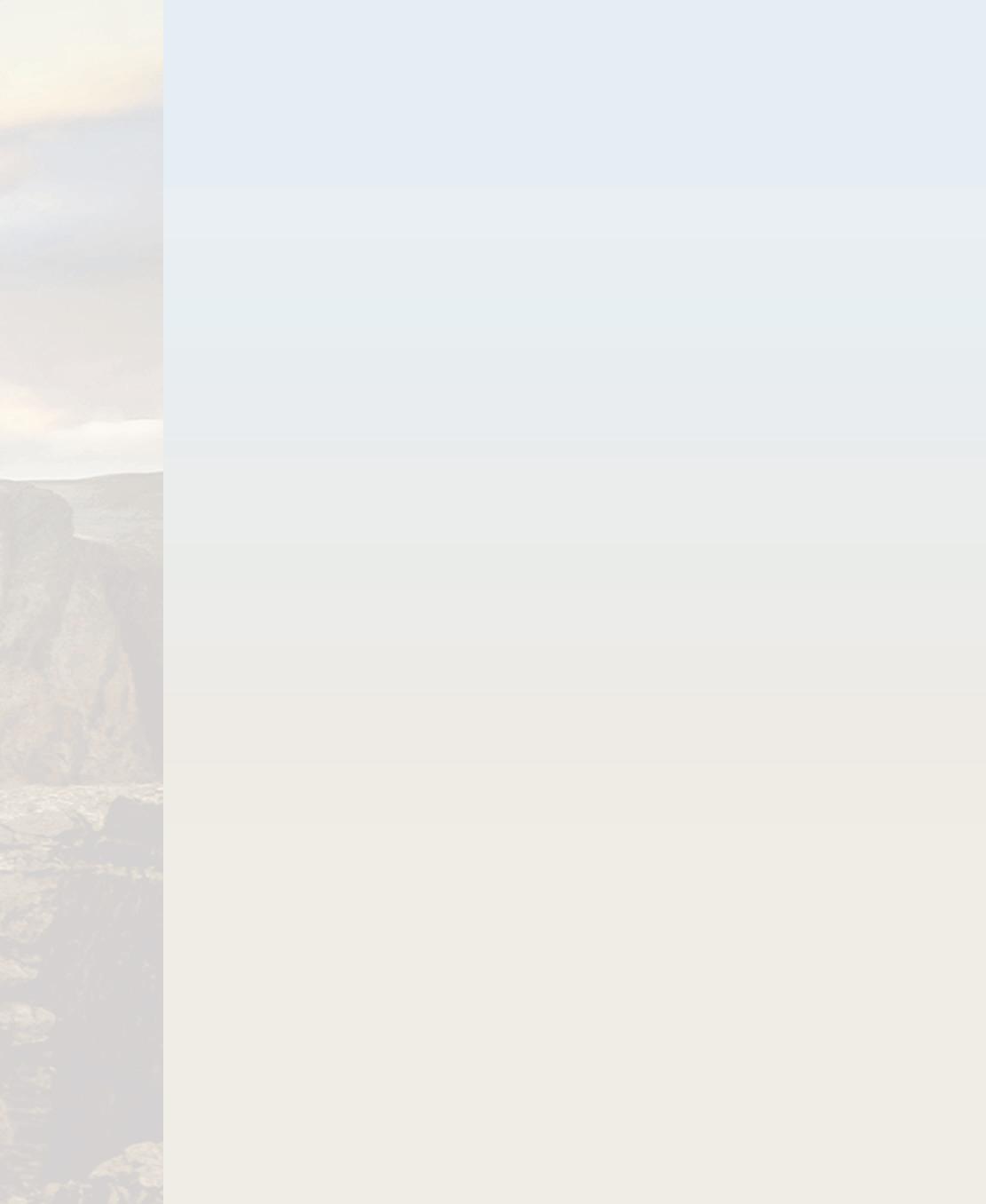

inside LABRADOR 37 FALL 2022
In June 1942, the 139-tonne motorpowered schooner EMA Frampton (built in 1935 by the Frampton family of Gin Cove, Smith’s Sound, NL) left St. Lawrence on Newfoundland’s Burin Peninsula bound for Saglek. The captain, Ralph Smith of Hodge’s Cove, Trinity Bay, and his crew of five were employed in the most secretive mission undertaken by the Allies during WWII. Also on board were 15 miners employed by an American company, The St. Lawrence Corporation of Newfoundland, which owned part of the fluorspar deposits near that town. It also carried mining equipment, including a bulldozer, to reach the known Saglek Fjord graphite deposits located several miles inland. The only surviving member of this mining crew in 2022 is 97-year-

old Augustus (Gus) Etchegary, a noted fisheries advocate. At the time he was 18 years old and given permission by his father, the mill manager at St. Lawrence, to be a member of the mining crew.

Between June and October, the St. Lawrence mining crew extracted 15 or more tonnes of graphite near Saglek Fjord. The EMA Frampton was used as a base of operations, and in October it delivered the valuable, top secret goods to St. Lawrence. From there it was transferred to a transport vessel from Delaware, USA, and eventually delivered to Oak Ridge, Tennessee.





The US Corps of Engineers had already commenced the acquisition of a large tract of land at Oak Ridge for the next phase in the Manhattan Project. By the spring of 1943, a massive

38 inside LABRADOR FALL 2022
Ralph Smith skippered the EMA Frampton to Saglek Fjord on a secret mission in 1942
Gus Etchegary still chuckles over having entrusted his crop of hair to Captain Ralph Smith on the stern of the EMA Frampton as it lay at anchor in Saglek Fjord, in the summer of 1942.





construction project was underway, including the installation of a graphite reactor. The purpose of this reactor was to demonstrate the production of plutonium from uranium; the graphite bricks would act as a moderator to reduce the speed of
atomic neutrons and allow a nuclear reaction to be sustained. The first plutonium was produced at Oak Ridge in early 1944, and on July 16, 1945, the first atomic test under a secret “Trinity” code was conducted in New Mexico.
The EMA Frampton , built and owned by my grandmother Jessie (Dalton) Dean’s extended family, met its fateful end on October 30, 1951. It was wrecked at Huntington Island, Labrador, while sailing in ballast from Goose Bay, Labrador, to St. Julian’s on the Great Northern Peninsula of Newfoundland.
That vessel and its crew played a critical role in the outcome of the Second World War, which ended when Japan surrendered on August 14, 1945, after the United States dropped nuclear bombs on the cities of Hiroshima and Nagasaki. Some nine years later, my brother Eli and I took proud possession of a new Raleigh bicycle brought from St. John’s to Southport in Kenneth Smith’s schooner, the Hubert G. Smith – captained by the very same Ralph Smith. Now, some 80 years later, the imprint of the bulldozer trail left by the St. Lawrence graphite mining crew can still be seen on the Labrador landscape.
inside LABRADOR 39 FALL 2022
BY NICOLA RYAN




40 inside LABRADOR FALL 2022
The Association for New Canadians and the Menihek Nordic Ski Club team up to offer fun nights of skiing and snowshoeing to newcomers.
ANC photo
Newcomers arrive in our province from all over the world, for all sorts of reasons. Talented folks come to work, students come to further their education, and families arrive to find peace and security. They arrive in Labrador from far flung lands – the Philippines, India, Guyana and others – but they all have one thing in common: the opportunity to enjoy the Labrador way of life.
Bill Soper is the Regional Settlement Coordinator of the Labrador branch of the Association for New Canadians (ANC). The ANC is a non-profit, community-based organization that delivers support, resources and information to immigrants and refugees in Newfoundland and Labrador. The Association ensures newcomers get assistance with practical things like obtaining MCP cards and transferring driver’s licences. But more than that, the ANC is there to help them find a sense of community. Bill has lived in Labrador for some 60 years and joined the ANC in 2019.
“What we’re trying to do is welcome the newcomers that come to the community,” Bill says. “We offer help and support with applications and things, but moreso we try to get them to get involved with the community. We’ve had things like potluck suppers and conversation cafés, where they can practise their English. But, with my background, I wanted to give [the newcomers] a chance to try an outdoor, Labrador-type activity.”
Bill moved to Labrador as a child
and says skiing – both cross-country and downhill – and snowshoeing were activities that he and his family always enjoyed. A few years ago he got the idea that for multicultural month in March, he wanted to give the same experience to newcomers to Canada. He approached the Menihek Nordic Ski Club to see if they’d be interested in helping out.

“They’re well known in the community and they’re always looking for new members, so of course when I approached them and asked them if they would do a little event, it was kind of a no-brainer,” he says.
The Menihek Nordic Ski Club has been around since 1975, and Labrador West has earned a reputation as one of the finest areas around for winter sports. The club maintains 40 kilometres of the best cross-country ski trails in eastern Canada and has a spacious lodge with meeting rooms, a bar and canteen, and a complement of rental skis and snowshoes. Family and community are guiding philosophies at Menihek, so it’s the perfect place to host a multicultural evening of snowy fun.

inside LABRADOR 41 FALL 2022
After some COVID delays and with the receipt of government funding, the first event took place in March 2021, and introduced newcomers to snowshoeing. “The reason we did it as a snowshoe event was it was probably going to be more value for them to go up and learn how to snowshoe than learn how to cross-country ski in one evening,” Bill laughs. “If you know
anything about cross-country skiing, it takes a little while to get good at it. Snowshoeing, you put the snowshoes on and if you can walk, you can snowshoe.”













Close to 30 participants signed up for the snowshoe event. “We had people from all different countries, from all over,” says Bill. “We have a large Filipino population in this area. And

42 inside LABRADOR FALL 2022
Some newcomers enjoying the Labrador outdoors arranged by the ANC and the Menihek Nordic Ski Club. ANC photos
there were people from India, Peru, Columbia, Cuba, Guyana. It’s really, really neat.”

Fitted out in snowshoes and woolly layers, the participants were guided around the snowy trails, stopped for cocoa at the Whiskey Jack Hut and enjoyed the beauty of the outdoors under the cold, clear sky.
“When people first get here we talk about the cold and how to dress and stuff like that, but they quickly adapt,” Bill says. “A lot of them, to go up, are just amazed by the nature. You’re up in the woods, the snow is crunchy… In the woods they found it really good, they were looking for animals, taking pictures of each other,” says Bill. When the group returned to the Menihek chalet, they were warmed by a hot meal cooked up by Menihek staff and volunteers.
“It was a tremendous evening, the way it worked out,” says Bill. In fact, the event was so successful, Bill and the ANC started planning the next one for 2022 – this time bigger and better with snowshoeing plus crosscountry skiing. “Menihek Nordic Ski Club is a ski club,” Bill points out with a laugh.
With funding from the Iron Ore Company of Canada and some extra volunteers, the 2022 event took place in April. For many of the new Canadians, it was their first time ever on skis. Menihek Nordic Ski Club volunteers offered instruction and plenty of encouragement, and the participants had a blast.
“The Menihek crowd are just super,” Bill says. “They bring their volunteers in, they suit people up with skis or snowshoes. They go out on the trails with them and take care of them, show them around and do the
Goose Bay
www.cafconnection.ca gbmfrc@nf.sympatico.ca




P.O. Box 69, Station C Goose Bay, NL A0P-1C0 (709)896-6900 ext.6060 (709)896-6916 (fax)



inside LABRADOR 43 FALL 2022
amount of trail they know the beginner is able to cover.”



After the lesson, there was another big mug-up at the chalet. “God love the girls,” says Bill. “They went and did a spaghetti supper. So [the newcomers] had a night of snowshoeing and skiing out on the trails, and then after that they came back in to the beautiful chalet, tables all set, and sat down and had a dinner. Some local businesses donated things, and I put their names in a hat for prizes and stuff, too. A really, really nice evening, yeah.”
“Our manager at the club and
people at the chalet, they really enjoy doing it,” says Gerry Rideout, president of Menihek. “We make sure that the snowshoe trails and the ski trails are groomed for them, and we set up a firepit at one of the warming cabins. When they return they have a bit of a social at our ski chalet. They really enjoy it. We’ve had some people come back and join the club.”
For everyone involved, the ANC ski/snowshoe nights at Menihek are a huge hit and Bill’s already thinking about next year. “It’s becoming a tradition right now,” he says. “It’s just beautiful.”

44 inside LABRADOR FALL 2022
After a day of outdoor fun, newcomers to Labrador enjoy a dinner at the Menihek Nordic Ski Club chalet. ANC photo




inside LABRADOR 45 FALL 2022
“Inuk Starry Night” (2019)




 By Jason Sikoak
By Jason Sikoak
46 inside LABRADOR FALL 2022
BY NICOLA RYAN
Full 40 fathoms deep she’s said to dwell. Half woman, half fish; floating in the inky depths of the Arctic Ocean. For thousands of years she’s been known to the people of the Inuit Nunangat, though they usually only whisper her name –Sedna, goddess of the sea.
Inuk artist Jason Sikoak heard the story of Sedna growing up in Rigolet, on the north coast of Labrador, as he watched his uncle carve and create art.

“I started creating artwork when I was really young,” Jason says. “I got into it watching my Uncle Jack Mugford carve and whatnot as he passed the time. When I got older I started creating on my own, pencil and paper starting out.” Jason’s now an art student at Concordia in Montreal, QC, working on a Bachelor of Fine Arts double major in Studio Arts and Art History. His work is featured on a new commemorative silver coin from the Royal Canadian Mint, part of the Mint’s Generations series celebrating Indigenous storytelling and the art of gifting knowledge.
The competition came as a surprise to Jason. “It was in the middle of hardcore [pandemic] lockdown here in Montreal; it was pretty bleak. I opened my email one day and there was this email
inside LABRADOR 47 FALL 2022
A design by artist Jason Sikoak is featured on a new silver coin from the Royal Canadian Mint.
“I came up with a design that I thought would represent Inuit Nunangat, the Inuit homeland, best,” he continues. “And the one story I could think of was the story of Sedna. That story is told all across the North, and I figured that’d be good.”
from the Royal Canadian Mint –which at first I thought was spam,” he chuckles. “It said they were given my name by Inuit Tapiriit Kanatami (ITK), the national Inuit organization. So I opened the email and it was like, you can submit your artwork to be entered into the competition for the Generations series, which features Inuit and Métis First Nations coins all in sterling silver.
“I came up with a design that I thought would represent Inuit Nunangat, the Inuit homeland, best,” he continues. “And the one story I could think of was the story of Sedna. That story is told all across the North, and I figured that’d be good.”



The story Jason knows, and he’s thoughtful to point out that there are many variations and he’s only speaking from his own experience, goes like this: Willful Sedna is cast into the sea by her angry father. When she grabs ahold of his kayak, he chops off her fingers. The severed pieces are transformed into all the animals of the sea, and Sedna controls them from her watery realm. For the Inuit who depend on marine mammals for survival, keeping Sedna happy is the difference between life and death.
“The very quick version is when we
do something wrong that displeases her, like act in a way that’s not proper, I guess, she’s upset and her hair becomes very tangled. She captures all the sea mammals in her hair and that’s when hunting is poor and food is scarce. So then someone has to perform a ceremony where they sing to her or comb and braid her hair and make her happy again – thus releasing all the sea animals back for successful hunting – to appease her.”
Inuit mythology is a theme Jason has been exploring in his artwork, and he thinks it’s neat that folks from Greenland to Alaska share the same reverence for Sedna. “Thinking about back in the day, way back, travel between different regions and communities wasn’t unheard of, but it was very rare. So for all of Inuit Nunangat to have slightly different versions of the same story is pretty amazing. Maybe there’s some truth to it,” he adds mysteriously.
Jason’s decision to enter the competition was inspired by his admiration for another Inuk artist. “Years ago, when Nunavut ratified their land claims agreement, the Mint celebrated by minting Germaine Arnaktauyok’s design on the toonie,” he recounts, describing Canada’s first $2 commem-
48 inside LABRADOR FALL 2022
orative circulation coin, which featured Nunavummiut artist Germaine Arnaktauyok’s design of a stylized Inuk drum dancer on an outline map of Nunavut. “I held one in my hand years ago and was like, ‘Maybe someday my artwork will be here. Hopefully, one day I’ll be good enough.’”
Jason said he submitted his design and promptly forgot about it in the weird time warp of the pandemic, until one day about month later, when he got a call from the Mint. “And the person on the other end of the line said, ‘Congratulations, your design has been accepted!’ I think we talked for another 10 minutes, but I can’t remember much of the conversation after that. I was just blown away.”
Jason’s coin was the first in the Generations series, which celebrates Indigenous storytelling and the passing down of knowledge. “In Labrador, we were colonized very early. A lot of our customs, traditions, traditional storytelling were lost throughout the ages,” he says. “But it seems like this story is one that we’ve always heard. The younger generation, like younger than me – I’m pretty old – are now coming into their own thanks to our land claims, and teaching, and learning from elders and whatnot. So I’m hoping that this is helping in
some way.”






































The one-ounce sterling silver coin is available on the Mint’s website and there is a limited run of 5,000. “I got one and held it in my hand,” Jason says, and he sounds like maybe he’s still not sure it’s real.

But it sure is real. This past summer, Jason was at the Inuit Studies Conference in Winnipeg, MB. “Just randomly, at the Winnipeg Art Gallery gift shop, I saw a sign saying that Germaine Arnaktauyok is going to be here signing autographs.
So I grabbed her book, My Name is Arnak, and I have a picture of me uglycrying meeting Germaine. It was pretty amazing. And she held my coin in her hand. Like, that whole story for me just came full
Jason dreams of being an artist full time. “Someday I hope to open my own studio. Not just a studio for me, but I could bring in emerging artists as a teaching residency; and bring in other Inuit artists that are in the field of interest of the people that come in; and have it as a working/teaching group with a gallery attached. As for right now, I might jump right into my masters after I’m done this – I know, sucker for punishment. I’m finally living my dream of being in art school, and it’s awesome.”
inside LABRADOR 49 FALL 2022
Views of Red Bay

Some Snow
This was the scene in Red Bay on February 27, 2022. MARY




 YETMAN
YETMAN
Red Bay, NL
50 inside LABRADOR FALL 2022
Inuksuit Lookout
These three inuksuit were at the harbour entrance of the cruise port of Red Bay.
ROBERT CARTER Chamberlains, NL
Sea Level




The fog retreated to show this view of Red Bay, famous for being a base for Basque whalers in the 16th century.
 CINDY BURLEY Ontario
CINDY BURLEY Ontario
FALL 2022 inside LABRADOR 51
BY LINDA BROWNE







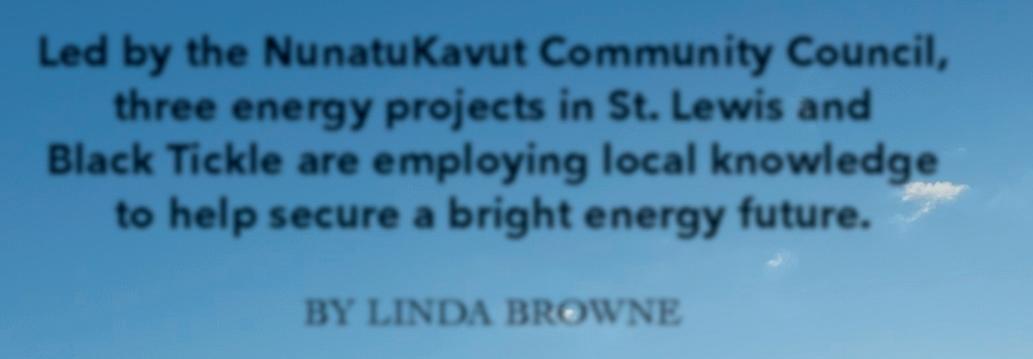
FALL 2022 52 inside LABRADOR
Led by the NunatuKavut Community Council, three energy projects in St. Lewis and Black Tickle are employing local knowledge to help secure a bright energy future.
Climate change is, without a doubt, one of the most pressing and important issues of our time. It’s a concern in every corner of the globe, including here in Newfoundland and Labrador.
Many rural and remote communities in Canada, including those in Labrador, rely on diesel fuel to generate electricity, but this comes at a heavy cost, both environmentally and financially. That’s why there’s a push to reduce reliance on diesel, a move that’s being embraced by both businesses and communities. (The Voisey’s Bay Wind Energy Project, released from the environmental assessment process this past spring, for instance, proposes to build five 4.2-megawatt wind turbines to help offset more than 13 per cent of the mine’s diesel requirements.)

FALL 2022 inside LABRADOR 53
A 50kW solar installation in St. Lewis
Nick Mercer photo
The NunatuKavut Community Council (NCC) is the representative governing body for approximately 6,000 Inuit who live primarily in south and central Labrador. This past June, they announced $1.6 million in funding from Natural Resources Canada for three energy projects in St. Lewis and Black Tickle as part of Impact Canada’s Indigenous OffDiesel Initiative.

The initiative, says Krista Oxford, NCC project and implementation manager, “is aimed at reducing Canada’s carbon footprint across Indigenous communities, and they focus on helping communities reduce their reliance on diesel and move toward more renewable sources of energy.” This is the third year that NCC has received funding under the program, which works with local Clean Energy Champions in each region to develop and carry out energy plans based on research and community feedback. (In NunatuKavut, the work is being led by NCC’s Department of Research, Education and Culture, and NCC’s energy champion, Siobhan Slade of St. Lewis.)
“NCC and Siobhan have been working at implementing each phase... we’re taking it in phased approaches, as pilot projects, and taking our time
rolling it all out,” Krista says.
As part of the program, NCC is leading two solar demonstration projects in St. Lewis and Black Tickle. “We will release an expression of interest this fall to execute those projects next construction season,” she says.
The two existing solar energy projects in the territory – one in Mary’s Harbour (believed to be the largest



54 inside LABRADOR FALL 2022
Krista Oxford is the NCC Project and Implementation Manager.
solar installation tied to the grid in the province, with 150 kilowatts of solar capacity), and another in St. Lewis –are not owned by NCC but by private sector partners. However, regarding the Mary’s Harbour project, Nick Mercer, a postdoctoral research scholar at Dalhousie University and independent energy adviser to NCC, says, “We’ve been watching this project with a careful eye because it’s in the heart of the territory (and) it’s one of

The Heat of the Matter

The solar pilot projects are just one part of NCC’s mission to reduce a reliance on diesel. A Home Energy Retrofit Program (in the planning stages as of press time) and High Efficiency Woodstove Program (to be

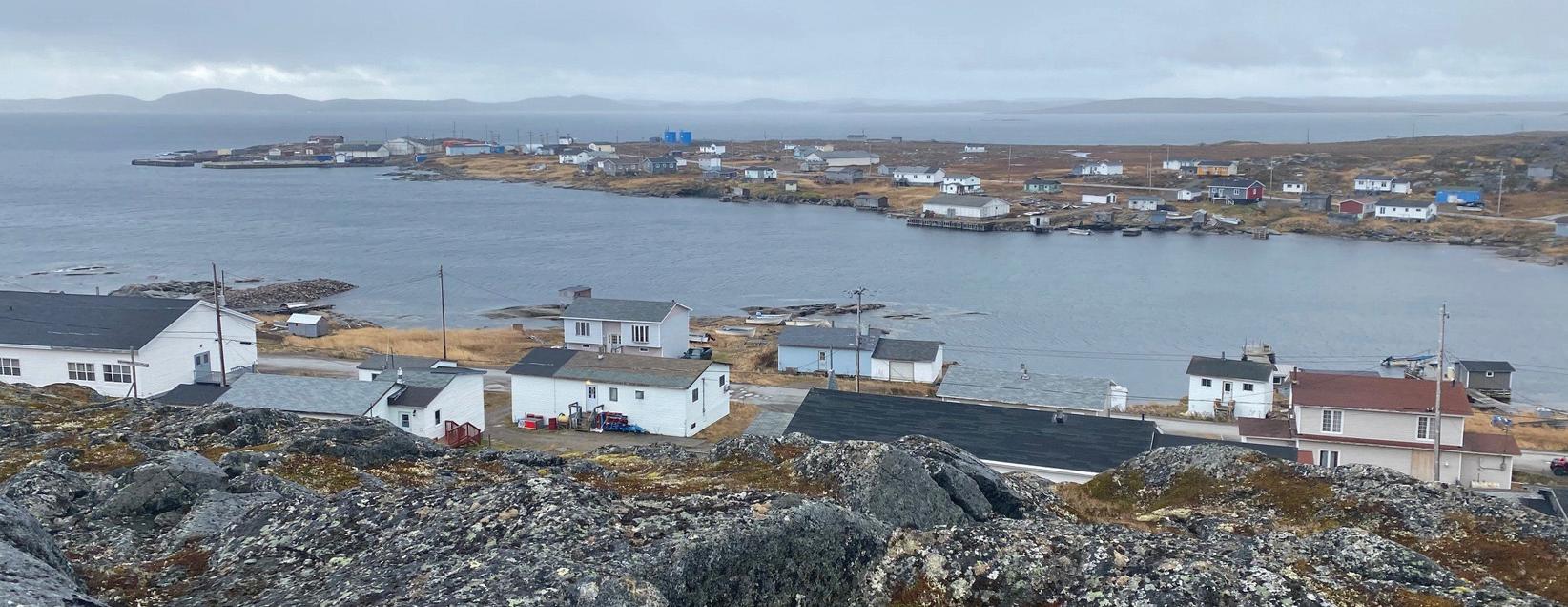
inside LABRADOR 55 FALL 2022
the successful technological examples in the North of how we can displace diesel and have positive community impacts.”
NCC is leading two solar projects in St. Lewis (above) and Black Tickle (below)
Krista Oxford photos
rolled out as a pilot project in Black Tickle this winter, and in St. Lewis next season) will also work towards that goal, while helping make communities more sustainable and selfsufficient along the way. The highefficiency stoves burn less wood than traditional ones and emit less pollutants than diesel. Thirteen households in Black Tickle have been preapproved for the program, Nick says, which aims to provide a woodstove to every winter resident who wants one.
“The hope is for all three initiatives... that we can test these things out in the communities that most desperately need them, with the eye to potentially expanding to other NCC communities – if we have a good experience and if resources permit,






and if we have open recipients in the other communities. So this is a bit of a learning experience for us with an eye to the future as well.”
NCC’s approach with these projects, Nick says, is unique in that it puts the focus on “the individual, the family and the household in order to ensure the greatest energy security impacts as possible,” while getting community members engaged in the process by providing their feedback and ideas with regards to what they want and need. Their ultimate goal, “isn’t to build out a ton of renewable energy capacity or to make a bunch of money off renewable energy technologies,” but to “benefit NunatuKavut Inuit, to benefit NCC’s membership, to the greatest extent that we possibly can,” he explains.
56 inside LABRADOR FALL 2022
Nick Mercer, an energy advisor for NCC, is paying close attention to the solar installations built by private corporations, such as the 150 kW setup in Mary’s Harbour (above). Nick Mercer photos
“And one thing that we discovered in our analysis, our research and our community energy plans is that when you pursue energy efficiency technologies, like a high-efficiency woodstove or home energy retrofits, it’s the person who’s living in the house who benefits the most. So they have a cheaper heat bill, they have better heat retention, they have more comfort, they have an enhanced quality of life… and it’s by doing these household-level activities is how you maximize benefits for Indigenous peoples,” he says.
“When you put in a heat pump in someone’s home, for instance, you guarantee that it’s the homeowner that benefits. Whereas if you put up a bunch of wind turbines or solar panels, it’s a little more indirect; there’s no guarantee that the homeowners will see financial impact at the end of the day.”

In 2018 and 2019, Nick says, they did extensive community energy planning research across NunatuKavut and found that the greatest energy-related challenge was “heat insecurity” –access to clean, reliable and affordable heat – with up to one-quarter of residents in southern Labrador living in inadequately heated homes. This, he adds, has “considerable” effects on physical and mental health.
“Living in a cold home can lead to cardiovascular disease; it can lead to respiratory illness; it can exacerbate minor illnesses like the cold, the flu and arthritis. From a mental health perspective, we know that living in a cold home leads to degradation of mental wellness; we know it leads to insomnia as well. We interviewed one respondent who said, ‘How am I supposed to sleep when it’s cold?’ or ‘How

inside LABRADOR 57 FALL 2022
am I supposed to send my kids to school when they’re living in a cold home?’” Nick says.
“So our research really suggested to us that heat insecurity is a borderline crisis in the territory, and if we’re going to direct our efforts anywhere, it should be making sure that people have a secure and reliable and affordable heat source.”
Communities at the Forefront
While the renewable energy industry in the North offers lots of opportunities, Nick says, it’s often outside companies and workers that benefit from jobs, education and training. That’s why NCC is focussing on building capacity within their own communities. This past summer, they launched an initiative as part of the Home Energy Retrofit Program that saw four young Indigenous women (Victoria Keefe and Tara Keefe in Black Tickle, Cassandra Curl from St. Lewis, and NCC’s Siobhan Slade) receive training to become some of the first certified energy auditors in Labrador. So when the program goes ahead, “we won’t have to import an expert from Toronto. We’ll have four fully trained Inuit women on the coast of Labrador who will be able to lead this in their respective communities,” Nick says. NCC also plans to partner an external contractor, who will supply and install the woodstoves, with a local contractor to do a skills transfer in training, “so that the next time we go to tender, it will be the local contractor who’s going to be able to build and lead these projects,” he adds.
Going straight to the community members, who Nick calls “the true PhDs,” for their ideas and input is the fuel that will fire the success of programs like the High Efficiency Woodstove pilot (which, he says, has received “unanimous support” from across the community).
“One thing we did that was really unique here is we didn’t just dream this project up on our own... Instead, through research, we deeply and proactively engaged the community to figure out if it was something they even wanted – and if they wanted it, how would they like to see it rolled out. And most importantly, whether or not they wanted us to go back to the drawing board to come up with a better idea,” he says.
Going straight to the community members, who Nick calls “the true PhDs,” for their ideas and input is the fuel that will fire the success of programs…

The solutions are already there, Nick says, you just have to listen. That’s one of his biggest takeaways from working with Krista, Siobhan and the whole NCC team.
“The question everyone always seems interested in is ‘How do we move southern Labrador communities towards sustainability?’ And I honestly think it’s the wrong question to be asking. I think the right question is ‘What can we learn from southern Labrador communities about how they’ve always practiced sustainability?’” he says.
“I think there’s a really sophisticated and rich Indigenous knowledge system in there that can teach us untold
58 inside LABRADOR FALL 2022
amounts about how we treat one another, about how we manage our lands and resources, about how we make fair decisions that benefit everyone in the community. So I think we just need to open our ears and be receptive to what the elders and the culture keepers and the knowledge holders already know. We don’t need to recreate the wheel here.”
When it comes to their energy futures, the power is within the people. And it’s a future, Krista says, that she feels positive about.
“It’s very important for us to get it




right, and to get it from the community members. The research that we do, it’s important that it’s thorough and inclusive and engaging. We offer [the] opportunity to everybody to give their feedback... it’s important for NCC members and for our people to be involved in the decisions that are being made about our communities,” she says.
“I think as long as we take our time and we’re thorough, and with the best interests in mind for our people, we have a bright future. I’m optimistic about it.”

inside LABRADOR 59 FALL 2022
Community engagement is part of the NCC mandate. Here is a Conservation Corps of NL team in Black Tickle. (L-R) Chelsey Hicks, Cassandra Curl, Siobhan Slade, Tara Keefe and Victoria Keefe
BY RETIRED PILOT TOM GREEN

On December 23, 1984, we brought home every patient at St. Anthony hospital who was discharged for Christmas. We flew them to Port Hope Simpson, Paradise River, Cartwright, Black Tickle and Fox Harbour.



When I went by Charlottetown and Port Hope Simpson, I radioed the nurses on the ground to ask if there was anyone else who might need to come to the hospital at St. Anthony. I explained that we weren’t planning any flights on Christmas Eve and Christmas Day, except emergencies.
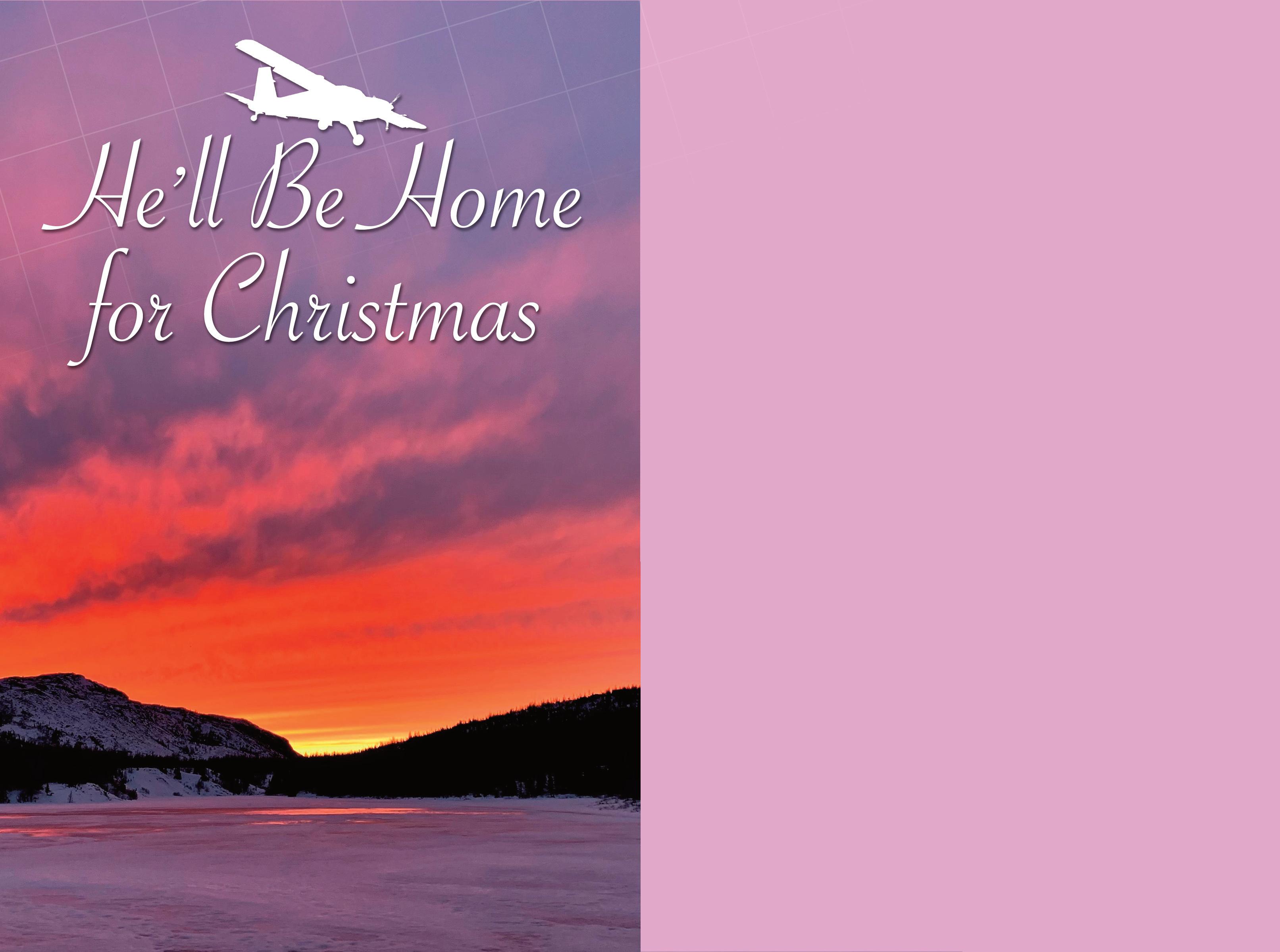
60 inside LABRADOR FALL 2022
A last-minute Grenfell Mission flight to reunite a Port Hope Simpson family
Just after I left Fox Harbour, the nurse from Port Hope Simpson called me. A nine-year-old boy had just fallen down a flight of stairs, and they thought his arm or leg (I don’t remember now) might be broken or dislocated. He needed to go to the hospital for an x-ray. I changed course for Port Hope Simpson.
I landed and the little boy with his parents were waiting on the airstrip. I explained that we were not planning to fly the next day, and wondered if the mother was coming, too. She said no, as she had more children at home and really couldn’t leave. I understood, and the young boy and I left for St. Anthony. I dropped him off at the hospital and returned to the skies for final trips to Blanc Sablon, Mary’s Harbour and Fox Harbour before ending my shift back home at St. Anthony.
I was thinking about the little boy all that evening at home, wondering how he was doing. Next morning I called the hospital to check on him, and they told me he was discharged and ready for home. Turned out his limb was bruised, not broken.
It was Christmas Eve and any flights that day were limited to emergencies, but I couldn’t leave him there when he had no reason to be there and not with family. I called the RT operator and told them to get him ready; I would take him home for Christmas.
Before takeoff, I took several cushions from the rear seats and propped up the boy so he could see out the front window, and I gave him a set of headphones for the flight. Port Hope Simpson is 90 miles from St. Anthony as the crow flies, about a 40-minute flight.
After we got to an altitude around
6,000 feet, I levelled off. I switched over the controls to the boy’s seat and gave him a five-minute lesson in flying. He caught on pretty good. I told him to head for a spot way ahead, where I knew it was near Port Hope Simpson, and off we flew! Once we neared Port Hope Simpson, I took back the controls and we landed on the airstrip. The boy ran out the back door and over to his father’s pick-up, excitedly telling his mother how he was “driving Tom’s plane!”
They thanked me for bringing him home and drove away, down the road towards town. I went back to St. Anthony and had an enjoyable Christmas as I never had to fly on Christmas Day. Later on, I received a lovely card in the mail from the boy. He thanked me for allowing him to “drive the plane” and said he had a very good Christmas, too.

I often think of the numerous kids over the years who I allowed to fly the plane for a while. For example; I had to go to Makkovik to bring in a planeload of kids to get their ears drained. I had nine kids on board the airplane when I left Makkovik. After getting up to altitude, I was just settling back when I felt someone close to me. I looked around and there was a young boy about 10 years old, in a fur hat with the ear flaps down, smiling and looking at me! I asked him if he wanted to fly, and he said yes! He climbed up in my lap, and I showed him how to keep the airplane straight and level. Then, one by one, I had to give all the rest of the kids a turn flying! That passed away a bit of time on the way back to St. Anthony.
That was the way it was when flying for the Mission!
inside LABRADOR 61 FALL 2022
BY MONIQUE GUILDERSON via DownhomeLife.com





62 inside LABRADOR FALL 2022
This model is a replica of a Labrador schooner, a common fishing vessel in Newfoundland and Labrador in the late 19th to mid-20th centuries. Known as “floaters,” these vessels travelled north every summer to fish off the Labrador coast. At the height of the fishery, up to 500 boats would sail north every season to fish the Labrador.
The work was hard. The men on these vessels would live aboard ship for several months, fishing offside from small skiffs. The fish was cleaned and salted on deck before being stored in the hold below. The weather could be fierce, as ice floes and bergs were present even in summer. Men from coastal and island communities around Newfoundland made this yearly trip to feed their families through the winter.
The artist, Moses Collins (my greatgrandfather), would have been very familiar with this type of vessel living on Indian Islands, a small island community off the coast of Fogo Island. His grandson, Don Downer, recounted a childhood memory about seeing a large group of Labrador schooners in full sail filling the horizon on their way to start the fishing season in Labrador.
Moses’ brother, Al Collins, owned a Labrador schooner called the ACME.


Likely this model is based on that ship. Moses’ art career was cut short when he died from the Spanish influenza pandemic in 1918, at the age of 38.
Like most centenarians, this ship has seen a lot in 107 years, moving through several generations of family members over time and across great distances. It sits now in a place of honour in the front entranceway of Back to Health Chiropractic and Wellness Clinic in Lower Sackville, Nova Scotia.
Although Moses’ creation long outlived him, his descendants are still caring for the piece of history he left behind. It reminds us of our shared maritime history and tenacity. Look at how far we have progressed over the last century. Although current headlines would tell you otherwise, life is much easier now than it was during the last pandemic. If he were alive today, I’m sure Moses would agree, we have a lot to be grateful for.
inside LABRADOR 63 FALL 2022
photo finish


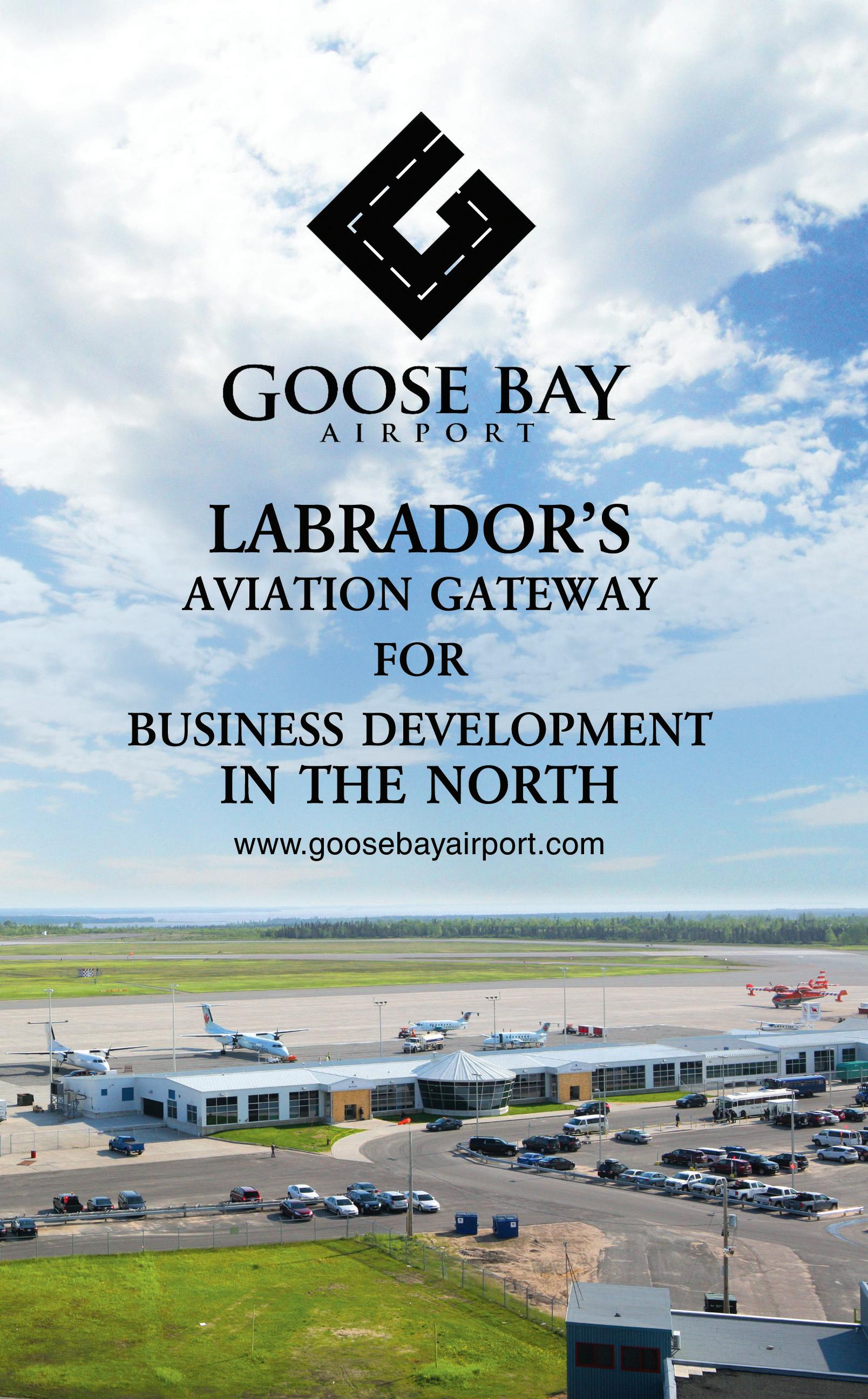







The Great Nanuk
A polar bear offers greetings during a Ski-doo trip north of Nain, Nunatsiavut. CONNIE PIJOGGE Nain, NL

64 inside LABRADOR FALL 2022









































































































































































 By Jason Sikoak
By Jason Sikoak









 YETMAN
YETMAN



 CINDY BURLEY Ontario
CINDY BURLEY Ontario



































